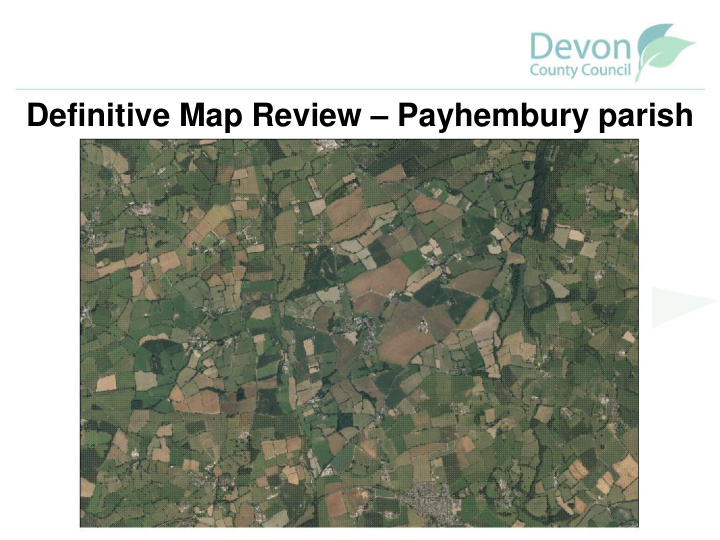



Definitive Map Review – Payhembury parish
Definitive Map Review – Payhembury parish • Public Rights of Way • Definitive Map and Statement • Payhembury paths • How the Definitive Map Review process works • What will happen next and how you can get involved
What are public rights of way? Walkers only Walkers, horse-riders and cyclists Walkers, cyclists, horse-riders and horse-drawn vehicles Walkers, cyclists, horse-riders, horse-drawn vehicles and motor vehicles
Payhembury Definitive Map • It is the legal record of the existence of public rights of ways. • In two parts: Map • Shows the route of the right of way Statement • Description of the right of way • Status Made in 1950s but drawn on Ordnance Survey 2 nd Edition 6” map from 1905
How did the Definitive Map arise? National Parks and Access to the Countryside Act 1949 Payhembury Parish Honiton Rural Paths were Council surveyed District Council and surveyed by C. J. paths in the parish in Devon County Jarvis, H. Daniel September 1950 Council added and W. L. Carnell. recommending which comments. ones they thought should be recorded as public rights of A draft map was published – the way. public could 1966 - final Once objections had object to errors or been determined a Definitive Map omissions – with provisional map was recourse to the published. published in 1963. Secretary of State.
Example of a route Payhembury Footpath No. 11 From: County Road A373 To: Hembury Fort The path is a Footpath. It starts at the Cullompton/Honiton Road, County Road A373, 150 yards south east of Hembury Fort Cross, and proceeds northwards looping over the remains of Hembury Fort, pre- Roman Fort of historical interest.
What rights of way are recorded in Payhembury parish? 4 Footpaths; 1 Bridleway They can be seen on: • Ordnance Survey Explorer Map – 115, Exmouth & Sidmouth (with Honiton) 1:25,000 scale • Internet: from www.devon.gov.uk/prow Public Rights of Way; where to Walk, Ride and Cycle in Devon; My Local Paths www.devon.gov.uk/mylocalpaths - interactive map • Definitive Map Review Parish Map
Parish Map
Why is there a Review? • Devon County Council - Surveying Authority • Statutory duty to keep the Definitive Map and Statement under continuous review (Wildlife and Countryside Act 1981) • Review process: on a parish-by-parish basis across the whole county • East Devon district: Payhembury’s turn to start next
Changes to the Definitive Map Changes that can be made through the review process need to involve existing rights, not desired rights (these are dealt with separately). Changes can include the following: • Adding a route that is not recorded as a public right of way • Upgrading or downgrading an existing recorded right of way • Deleting a recorded right of way, or amending recorded details in the Map & Statement that evidence indicates is wrong Reviews in 1960s and 1970s – not completed Also – Highways Act 1980: diversions funded by the landowners, within the parish and creations/dedications (ROWIP - Rights of Way Improvement Plan); extinguishments
How do changes happen? Definitive Map Review Procedure 1 2 3 Parish Map Old files checked Public meeting to prepared explain review procedure Informal consultation 6 5 4 Routes researched Public consultation Consultation map & evidence & schedule evaluated produced (Formal consultation)
Formal consultation 7 8 9 Report to Inform Parish & Order(s) published Committee - Local Councils Authority to make Order(s) (Statutory consultation) 10 Objection period ends 11 12 Order(s) referred to Unopposed Order(s) Opposed Order(s) Secretary of State Order(s) not Order(s) confirmed Order(s) confirmed confirmed
What evidence to gather? • User evidence forms • Landowner evidence forms • Documentary evidence: • Maps • Photographs • Estate plans • Other sources Report then submitted to Public Rights of Way Committee
Issues already identified – Hembury Fort Signs erected by landowner in 2012 stating ‘private woodland, no access’ or something similar. Devon County Council subsequently received many user evidence forms from people who had used various routes across the land and wanted them recorded as public rights of way. Will be investigated as part of this review.
What you need to do next... • Gather evidence of use, (supply of User Evidence Forms with the Parish Clerk, please attach maps to forms) • Come forward with any suggested changes to rights of way network • Locate any old parish maps and let me see them Any suggestions in by 14 th June 2019
Definitive Map Review Payhembury parish Tom Green Public Rights of Way Officer Devon County Council 01392 383000 thomas.green@devon.gov.uk www.devon.gov.uk/prow
Recommend
More recommend